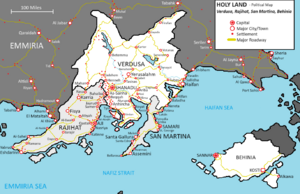Holy Land (CCA): Difference between revisions
(Created page with "{{Infobox historic site | name = The Holy Land | native_name = אֶרֶץ הַקּוֹדֶשׁ | native_language = Hebbi | native_name2 = Terra Sancta | native_language2 = Verdusi | native_name3 = الأرض المقدسة | native_language3 = Emmirian | other_name= | image = HolyLand_PoliticalMap_CCA-Verdusa-Behinia-Rajihat-SanMartina.png | alt= | caption = A political map of the Holy Land | locmapin= | map_relief= | ma...") |
No edit summary |
||
| Line 11: | Line 11: | ||
| alt= | | alt= | ||
| caption = A political map of the Holy Land | | caption = A political map of the Holy Land | ||
| type = Holy place | | type = Holy place | ||
| etymology= | | etymology= | ||
Latest revision as of 03:43, 14 May 2024
| The Holy Land | |
|---|---|
| Native names Hebbi: אֶרֶץ הַקּוֹדֶשׁ Verdusi: Terra Sancta Emmirian: الأرض المقدسة | |
 A political map of the Holy Land | |
| Type | Holy place |
| Location | Region between the Haifan Sea, Emmiria Sea |
The Holy Land is a region in southeast Adula considered holy to the three major Abrahamic religions— Judaism, Christianity, and Islam, as well as Rajitism. The region is defined by the Verdusa corridor, a series of peninsulas jutting into the Emmiria Sea and defined by the Haifan Sea. In the modern day, it is comprised of the nations of Verdusa, Rajihat, San Martina, and Behinia, with some descriptions also extending the Holy Land as far west as Al-Makkah in Emmiria. The significance of the land largely lies in its importance to biblical settings, and the 'center' of the Holy Land is the holy city of Yerusalahm. Many sites in the Holy Land have long been pilgrimage destinations for adherents of the Abrahamic religions, including Jews, Christians, Muslims, and Rajits.